
Shirin Neshat, Untitled, from Roja series, 2016. Silver gelatin print. Copyright Shirin Neshat. Courtesy the artist and Gladstone Gallery, New York and Brussels
Shirin Neshat is an Iranian-American artist based in New York. Her retrospective exhibition at the Modern Art Museum of Fort Worth, which opens to the public tomorrow, is made up of her acclaimed oeuvre of photography, video and film from the past 30 years. Neshat’s work has been extensively exhibited globally, and she has been awarded many honors including the Dorothy and Lillian Gish Prize, given to “a man or woman who has made an outstanding contribution to the beauty of the world and to mankind’s enjoyment and understanding of life.”
I’ve followed Neshat’s work for the past 20 years, and have been fortunate to see many of her New York exhibitions. She is truly one of my art heroes, and it was a tremendous pleasure and honor to interview her.
Colette Copeland: I remember seeing Rapture and Turbulent for the first time in New York in the early 2000s. Besides the stunning visuals and haunting music, what resonated for me was the “tennis court”-style perspective for the viewer. The opposing two-channel installation forces the visitor to take a position, since it’s impossible to watch both screens simultaneously. This has become a signature style, one that many other artists have emulated. Regarding your work, much has been written about the binary exploration of gender, as well as the cultural collision between East vs. West politics and cultural values, but I also interpret this viewing experience as a strategy, especially for a Western audience, to challenge their own views and ideologies. In more recent works such as Roja, Looking for Oum Kulthum and Land of Dreams, you’ve returned to a single-channel viewing experience. What is your intention for the viewer experience in both the two-channel and single-channel works?
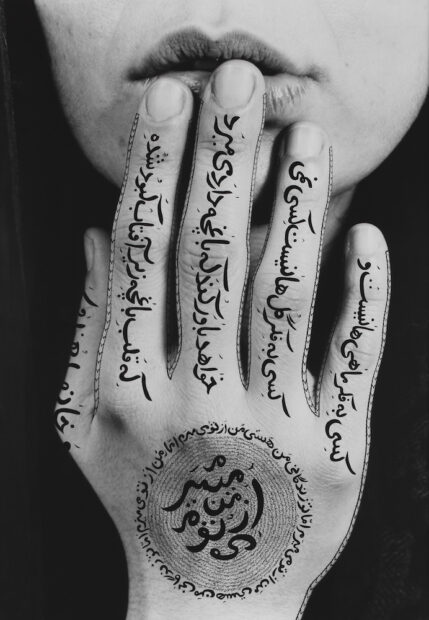
Shirin Neshat, Untitled (Women of Allah), 1996. Copyright Shirin Neshat. Courtesy the artist and Gladstone Gallery, New York and Brussels
Shirin Neshat: If you go back to my early work, such as the Women of Allah, as well as the early videos, there is always a notion of the paradoxical or duality both visually and conceptually. For example, in the Women of Allah photographs, there is a woman who is very sensual, yet is holding a weapon. Rapture and Turbulent are both about the masculine vs. the feminine. Rapture also has opposing themes of nature vs. civilization, and conformity vs. rebellion.
In terms of the viewing experience, although I had very little experience at the time with the moving image, I was very interested in getting away from the notion of the audience as passive viewers. When shown as a two-channel opposing wall installation, the work becomes very sculptural. The audience becomes a participant in the work; they are forced to emotionally and physically take sides. The duality does not escape them. I wanted to develop new ways in which to engage the audience in my work. I was never trained as a photographer or a filmmaker, so my work started from a very intuitive place, thinking about how I can further expand the idea of the opposites, as well as create something more immersive. To this day, I continue to work with the double channel short video installation, as well as more traditional feature-length films.
CC: When viewing your work in person, I have definitely experienced visceral sensations in my body, as I consciously realized that I’m making a choice, not only with my body language, but also my focus.
SN: Like in Turbulence, when you are listening to the music, whether you choose to pay attention to the man or the woman, it puts you in a dubious position.
CC: I agree. It forces the viewer to consider their own personal bias regarding gender. I find myself consciously wanting to side with the women and turning my back on the men. I realize that predilection/limitation in myself.
SN: In the beginning, it was easy for critics to reduce my work to a single interpretation of a Muslim woman artist portraying female oppression. When the artist is experimenting with the form, the work becomes about breaking down the structure of cinema and presenting multiple perspectives through the double-channel form. As I pursue my concepts and narrative, which are based on my culture, it’s important for me to continue to experiment with new ways of communicating with the audience.
CC: Your work employs historical and modern Persian literary and poetic influences. I was very happy to see and read so many of your inspirations translated in the exhibition catalog. It provides additional layers of context and meaning, and emphasizes important Iranian women writers. Forough Farrokhzad’s I Pity the Garden poem is such a vivid visual description, and evokes intense emotion. The refrain “Our garden is forlorn” symbolizes for me the environmental devastation humans have wreaked on the planet, but also the planting and sowing of our socio-political beliefs, culture and traditions. And as you mention later in the book, the tyranny of the recent former U.S. president and the damage he’s done to the world. How do you determine the relationship between the verbal and the visual in your work?
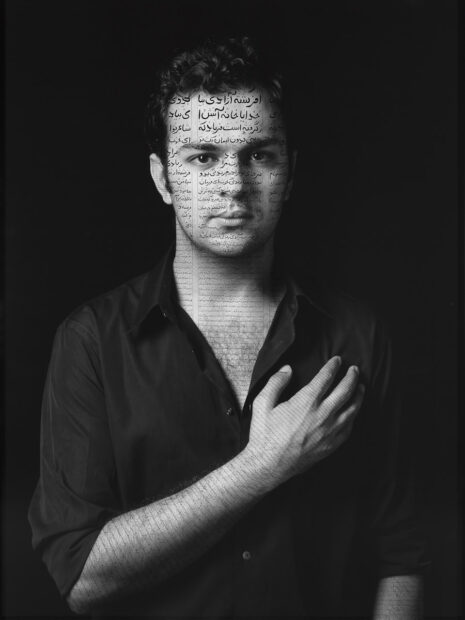
Shirin Neshat, Rahul, 2012. Ink on LE silver gelatin print. Copyright Shirin Neshat. Courtesy Galerie Jérôme de Noirmont, Paris
SN: Iran is a culture with a strong affinity to literature. We are a nation of ancient mystics, to modern poets and contemporary writers. The relationship of Iranian people to literature is very different from other cultures. We grew up memorizing lines of poetry and during gatherings, we would exchange lines of poetry to talk about politics, life, and existential issues. Literature was ingrained in our minds. I think part of that has to do with our long, dark history of dictatorship and censorship. Poetry and novels/fiction have been the only way that people can express themselves in a way that can transcend censorship; it’s abstract and subversive. People use allegorical and metaphorical language to say what cannot be said otherwise. The inception and initial inspiration of my art was visualizing Forough’s words. If I took the words out of the images, they would be meaningless. Forough’s work is universal, provocative and timeless in its resonance. She questions God about the creation of the female body, the idea of temptation, sin, guilt and shame. It’s such an honest conversation. Later her work was banned by the government. Throughout my career, I’ve continuously made work inspired by Persian historic and contemporary female authors, especially poets. Their words align with how I relate to the world.
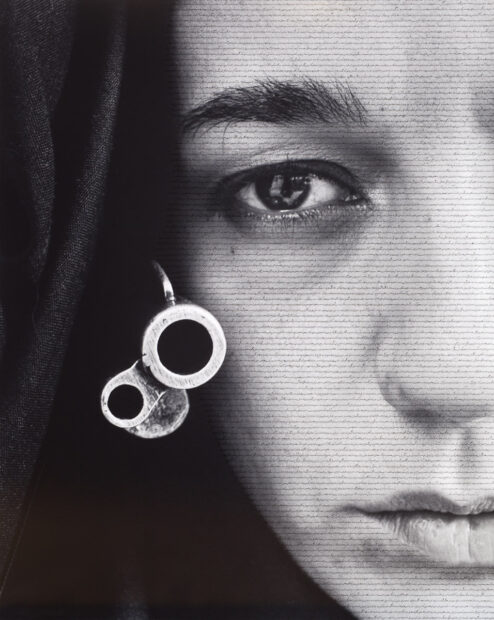
Shirin Neshat, Speechless, 1996. Gelatin silver print and ink. Copyright Shirin Neshat. Courtesy the artist and Gladstone Gallery, New York and Brussels
CC: One of the catalog essays mentions that many westerners (which I interpret as white Americans) don’t understand poetry, and perhaps that’s due to the fact that they’ve never had to speak in abstractions or symbolism, because they have not experienced persecution or oppression.
SN: That’s such a great point that you bring up. To bring an example, my film Woman Without Men, was a re-adaptation of a magic realist novel by Shahrnush Parsipur, one of Iran’s foremost important novelists. Although the book was quite surrealistic, the government, who imposes serious censorship on its artists, detected its subversive, sacreligious and even political nature, banned the book, imprisoned her for several years and eventually she was forced to leave Iran and live in exile in absolute poverty.
Years later, when my film was released in 2009, I remember a writer from one of the major American newspapers criticized the abundant use of allegory, metaphors and symbolism in the film, stating that it was confusing to try to decode the meanings. The writer was not aware that this strategy is a common non-western style of expression for practical as well as artistic purposes.
CC: At a CAA conference in New York in 2011, I heard you speak on a panel about censorship in the arts. There was one male artist in particular who spoke about his censored work that contained a Torah, Koran and a Bible. I remember you called him out, saying that until he had been exiled from his own country, and received death threats, he did not understand the true meaning or ramifications of censorship. That remark made an impact on me, and I often reflect on it. As an American middle-class white woman, I haven’t suffered discrimination due to my skin color or my religion. I have not feared for my life for publicly speaking my political beliefs. While gender bias and sexual harassment have been the norm throughout my professional career, I have not faced oppression or legalized violence due to my gender.
SN: I feel very privileged. I live a very comfortable life. But the reality is that my work is a product of the revolution — political upheaval that separated me from my family and my country forever. And the work that I made was considered a crime. It’s a strange idea to think that one’s art could become threatening to a major government. It’s inexcusable that art could be the source of danger to one’s life and homeland. It’s more dangerous for other Iranians, who fear for their lives and their families, as the government kidnaps and executes people.
This has put me in a specific relationship to the Iranian community. They pay attention to the films, photographs and the messages in the work, as well as the public statements to the media. One’s voice and one’s art really counts. The work is not just serving as entertainment or an elaboration on art history. It’s a mixed blessing to be born in a country that is harsh, without the freedom that many Western artists have. I do not believe that artists need to suffer to make important work, but I do believe that one’s perspective changes based on their experiences.
CC: You’ve risked your life, faced exile from your homeland and separation from your family, and acknowledged that you no longer have a desire to visit or return to Iran. How have your views about censorship and risk-taking changed over the past 30 years?
SN: I’ve had many conversations about this with other Iranian artists. We tend to censor ourselves, even if we live outside the country. Not because of our government, but disrespecting others who may have different cultural values or views. I’ve never made work that is intentionally offensive to anyone. However, even framing a certain subject has become problematic for the government. I am not interested in making comfortable work or work that preaches to the converted. There is a balance in making work that has a sharp knife, but is also filled with ambiguity, and open for multiple interpretations. I’ve been attacked from all sides — people who thought I was siding with the Islamic Republic of Iran, people who thought I was critical of the government, as well as people who thought I was criticizing American society.
CC: I remember being surprised when I first heard of your exile, since I did not consider your work a direct protest against the government. I find it interesting, as well as disturbing that the Iranian government felt so threatened by an artist’s work that was so beautiful, poetic, and symbolic.
SN: It’s strangely ironic that one of the most fanatical, vicious, uneducated, backwards governments in the world would cleverly read abstract, subversive, conceptual art work and understand the underlying messages. I imagine it’s the same for China. There are departments whose job it is to police the artists and detect subversive action.
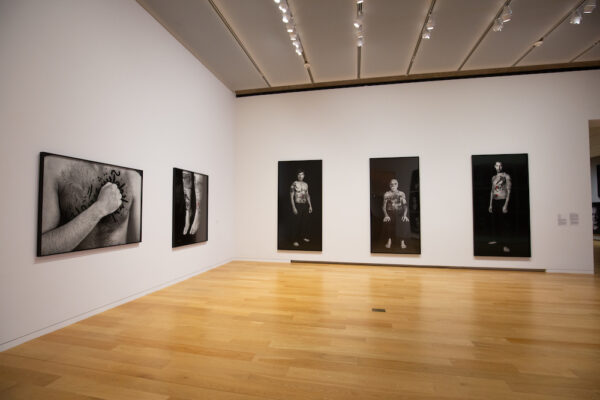
Installation view of Shirin Neshat: I Will Greet the Sun Again at the Modern Art Museum of Fort Worth
CC: Your portraits for The Book of Kings are powerful. I’m especially drawn to the photographs Divine Rebellion, Bahram, Amir and Sherief, where the bodies become palimpsests with the visual stories etched upon their skin (i.e. the surface of the image). Tell us about your decision to have the photographs depict a visual representation of the story, versus the text featured in the other images.
SN: The Book of Kings, completed in 2012, and the latest work The Land of Dreams, both explore illustration on the body. The title The Book of Kings comes from the long epic poem written by the ancient, mystic Persian poet Ferdowsi, between 977-1010 CE. The book is said to have saved the Persian language during the Arab conquest. His poetry is full of heroism, brutality and patriotism of the people who gave their lives for their nation. Iranian children grew up with these stories. My favorite illustrated book of Ferdowsi’s work was in black and white and portrayed the atrocity and violence of war.
My series The Book of Kings was about the Green Movement of 2009, where there was an incredible uprising. Young people took to the street demanding democracy. They were not trying to overthrow the government but were asking for freedom. The government retaliated and many of the protesters were tortured, raped and killed. My work connected the ancient history of Ferdowsi’s stories with the current events of Iran. I brought Ferdowsi’s illustrations onto the bodies of my subjects who represented the contemporary villains. The younger subjects who represented the protestors had lines of poetry from contemporary Iranian poets on their bodies. The work reflects how history repeats itself, addressing not only political history, but interweaving ancient and contemporary literature. The project took many years, with over 65 photographs. The four that you ask about are the only ones with illustrations; they literally embodied the violence and became the violence.
CC: The addition of the color red to the stark black-and-white illustrations also emphasizes the violence.
SN: Ironically, in my copy of the book, a child or someone had gone through the illustrations with a red marker and highlighted the violence.
CC: Two of your recent photographic series, Our House Is On Fire and The Home Of My Eyes, employ documentary strategies, departing from the earlier constructed tableaux series’ The Women of Allah and The Book of Kings. Working with your subjects, how did your approach shift both conceptually and visually?
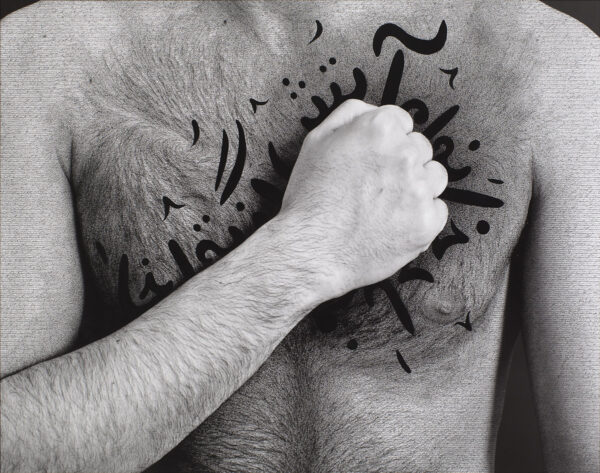
Shirin Neshat, My House is On Fire, 2012. Ink on LE silver gelatin print . Copyright Shirin Neshat. Courtesy Galerie Jérôme de Noirmont, Paris
SN: Our House Is On Fire represents the aftermath of the Arab Spring and the ways in which the families, the young people and the elderly, were adversely affected. It was the closing chapter to The Book of Kings. In terms of form, it is a narrative series of portraits displayed as a singular photo installation.
If The Book of Kings is like a portrait of Iran, Our House Is On Fire is a portrait of Egypt during a particular time in history. The subjects in The Book of Kings were friends, activists and people that I knew. For Our House Is On Fire, I traveled to Egypt and recruited real people who had experienced tragedy. I developed a relationship with them, building trust, so they would open up, sharing their stories of hardship and loss. The project was about connecting with people.
The photographer Larry Barns, who accompanied me, had also lost his 19-year-old daughter. A lot of tears were shed. I’m not sure the photographs accurately convey the depth of the emotions and experiences of so much loss. Later, I was criticized by a journalist for framing people’s suffering. But the project was about a profound, equal human exchange. The experience taught me a great deal. In The Home Of My Eyes, I continued this role as the interviewer, seeking out human contact and the sharing of stories, although always with a focus. In this project I asked the question, “What does home or the absence of home mean to you?”
CC: Trust is so important in projects like these. Your subjects are trusting you — not only to record their stories, but to share them with the world in a meaningful way.
SN: I had very mixed feelings after I came back. I wondered if it was morally acceptable to capture their pain. Later, I came to believe that they are emotionally powerful. Unlike images one sees in the media. The media tends to overlook the emotions of the people who are suffering. They focus on the suffering itself.
When you look at the portraits, you cannot escape their gaze. I’m very proud of that project. I don’t know if it’s art or not and I don’t really care. It was one of the most mystical and profound experiences I’ve had with people who I now deeply care about.
CC: As a witness, you were fully present. How often are we fully present with another other? That is very evident in the photographs, as well as portraying your subjects with tremendous dignity and respect.
SN: People like to be heard. Their stories are important and the process of sharing them is a healing experience. The act of sitting in front of a camera and getting one’s portrait made is also an important act. It inspires confidence. I would have a difficult time going back to my previous method of photography.
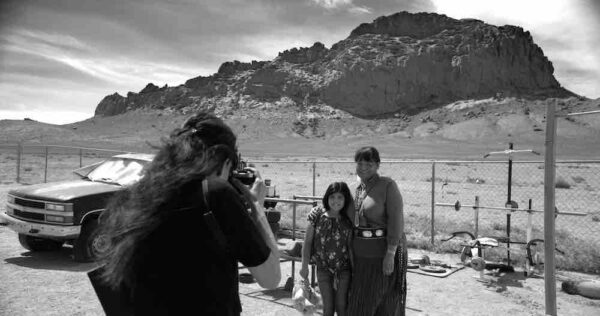
Shirin Neshat, Land of Dreams, 2019. Video Still. Copyright Shirin Neshat. Courtesy the artist and Gladstone Gallery, New York and Brussels
CC: Although employing traditional portrait techniques, the latest series, Land of Dreams, which was shot in New Mexico, seems to embody the conceptual and magical realism found in your earlier work. This project includes the photographic series and two videos, and also includes an upcoming feature-length film. When is the expected release date? And what is the holistic growth of the project as it evolves with the photographs, the videos and the film?
SN: With Land of Dreams, my intention was to make a portrait of America from diverse cultural perspectives. The formal language of the medium shifts with each form of the project, as do my collaborators, as well as where it will be shown — in a theater or in a gallery/museum. For the first time, this series existed simultaneously in all three forms with the same premise: dreams.
The story is about an Iranian woman who is obsessed with photographing people and collecting their dreams. The photographs become the product of the protagonist who was my alter-ego in the film and videos. The work is biographical in the sense that I am the Iranian woman who is interested in getting to know Native Americans, Black Americans and immigrants. In 2019, we traveled across the country and chose New Mexico, because the landscape resembles Iran, and demographically, there is a diverse cultural and racial population. In the spring of that year, my photographer, assistant and I went back to photograph people who were interested in the project, and we began work on the videos as well. We just finished filming the feature film in the fall of 2020, so now we are in the editing process. Hopefully, it will be released in 2021.
CC: I really enjoyed Farzaneh Milani’s essay titled Shirin Neshat: The Rainbow Catcher and her description of your work as a creation of magical, borderless spaces where communion and communication occur. Rather than focusing on the opposing, binary themes in your work, like so many previous scholars, she points out the collapse of boundaries, the liminal space where imagination and new possibilities germinate and grow. We as viewers become fellow travelers with insight into your worlds. Toward the end of her essay, when Milani discusses your work Looking for Oum Kultum, she cites the internal questions troubling the Iranian filmmaker who sets out to create a biopic about a legendary Egyptian singer. “How is she to portray the thousand and one paradoxes of a life metamorphosed into a legend in a visual language that is proper and befitting?” That statement seems to sum up your life’s work and journey to date. I personally related to that statement from a writer’s perspective in thinking about this interview. How do I narrow my ideas, when there are a thousand and one questions to consider, each taking us down a different pathway? In thinking about the many reviews, interviews and essays written about you and your work over the years, what have critics and scholars missed? What are the questions that you wish were asked or ideas that you wish were written about in your work?
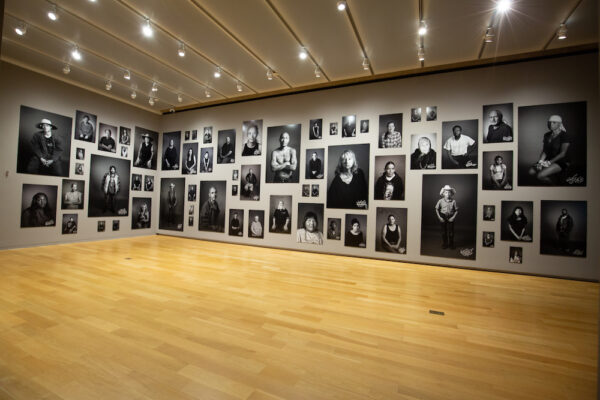
Installation view of Shirin Neshat: I Will Greet the Sun Again at the Modern Art Museum of Fort Worth
SN: I think some writers, especially Western writers, have missed the vulnerability or emotionality of the work, as well as my personal connection to the work. And perhaps as a writer/critic, not allowing for enough personal vulnerability to come through, admitting that they might not have all the answers. I’ve never made a single work that isn’t a reflection of myself or my own dilemma. Looking for Oum Kultum is about an Iranian director paying homage to her idol. Land of Dreams is about an Iranian woman immigrant in the U.S. Women of Allah was about me looking at Iran from a distance and coming to terms with the fanaticism.
Critics have analyzed the work in terms of gender and politics, but often miss the framing through the personal lens. The work is not autobiographical, but there are endless questions that I have about my relationship to Iran, my relationship to the U.S., my relationship to other vulnerable people, especially immigrants. I think that’s the beauty of art. It’s about artists asking questions, but not providing answers.
Shirin Neshat: I Will Greet the Sun Again is on view Feb. 28-May 16, 2021 at the Modern Art Museum of Fort Worth.



2 comments
Colette, thank you for such an insightful interview with Shirin Neshat.
I appreciate your conversations that enlightened her work regarding the complexities of gender, cultural and political “collisions”.
I especially am drawn to her use of poetry in her work and how “Poetry and novels/fiction have been the only way that people can express themselves in a way that can transcend censorship; it’s abstract and subversive.”
This show at the Modern is incredibly moving and your interview with Shirin excellent.
Carmen–Thank you so much for taking the time to read and comment on the interview. It’s interesting to see the complex layered textual palimpsests on the portraits in person at the museum, as well as read some of the poems in translation. The words become part of /ingrained upon the subjects’ skin/body. This is a show that I will have to return to multiple times in order to take it all in.